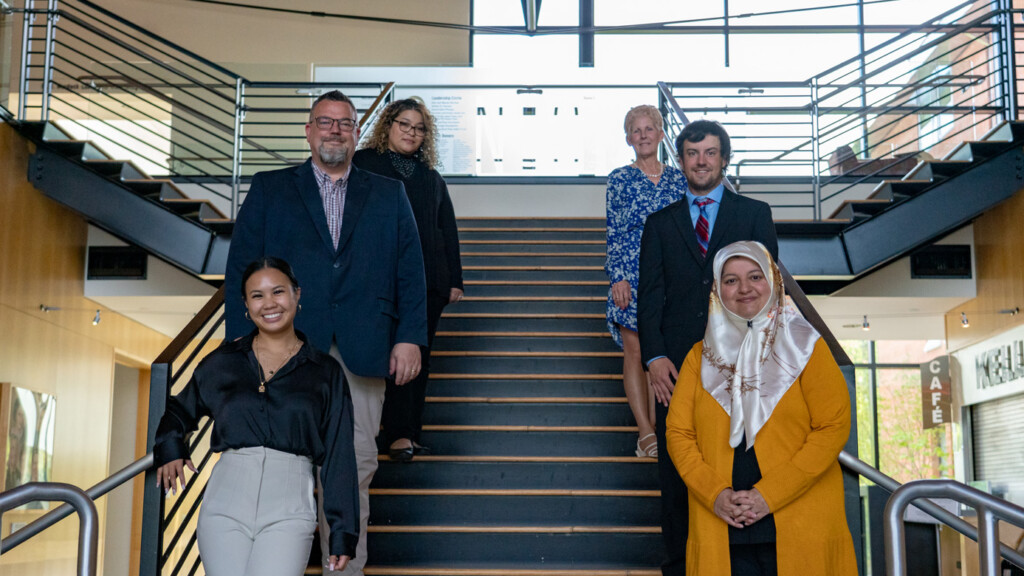Page 129 • (1,454 results in 0.065 seconds)
-
,” remembers Dean of Social Sciences Anna Leon Guerrero. “He was a veritable encyclopedia of sociology, able to offer his analysis of any classical or contemporary theory. He led by example and inspired me and our students to engage our sociological imaginations and to read and think more expansively about our discipline.” Arturo’s curiosity as a sociologist was endless. He researched and wrote on a wide range of topics including the sociology of revolution, a methological critique of studies of swinging
-

just doing that,” Nargesi continues. “We’re not training people to go be successful workers. We are trying to raise a generation of business people that care, who see the big picture and who are able to be problem solvers at an integrated level. Not just workers who repeat quantitative techniques.”That perspective rings true to business and sociology double major Allisa Ouanesisouk ’21. “My classes had the perfect balance of learning about how businesses are run and how to make the most ethical
-
Information(Vital Record) Official Copy: Humans Resources Retention: 50 years. Other Copies: Retention: Policies and Procedures (Vital Record) Provides a record of established policies and procedures for a department/office. Official Copy: Any department or office Retention: Until superseded. Transfer to University Archives Other Copies: Retention: Back to top R Research Data (Vital Record) Official Copy: Any department or office Retention: Permanent. Other Copies: Retention: Research Protocols (Drug
-
was reputable. Some disinformation or propaganda has been delivered by withholding information and deceiving the public, news outlets, and even researchers (Example: oil companies withholding important climate change data whilst supporting climate denier movements). Evaluation Methods Consult this section for different methods to evaluate information sourcesWho, What, Where MethodUse this method when encountering sources that you don’t know much about or when you are doing research in a topic that
-

gathered samples and expertly interpreted the amassed data. This research project was part of the Natural Sciences Summer Undergraduate Research Program (NSSURP). NSSURP allows student researchers to work directly with PLU faculty mentors to experience a learning dimension rarely accessible from the academic-year textbook and laboratory assignments. Research projects reflect the natural sciences fields of biology, chemistry, computer science, environmental studies, geosciences, mathematics, physics
-
. These types of projects demonstrate a student’s ability to think like a scientist and connect theory to practice. Beyond that, it trains students to think critically. “It’s one of the ways they develop habits of mind that are connected to being good citizens, too, because research questions are rarely neat,” Killen said. The process of developing a hypothesis, and determining how to explore that question and collect data, may look like a method useful only in academic research. However, Killen
-
, and deconstruct them and analyze them on a computer to quantify differences in the songs of the different call types. This is technical, dry work. But Grossberg is thrilled at the opportunity. “I just love being outdoors, and this gives you an appreciation for the overall research we’re doing and how all the pieces connect, how they all fit together,” he said. Scientific research, he’s learned, is 95 percent failure and 5 percent success. So there is a lot of slogging through data that may not
-

landed a position as a postdoctoral associate at the Yale Institute of Global Health in New Haven, Connecticut, where she spends her time analyzing factors that have caused child vaccination rates to decline in many parts of the country.Not that poring over such data was always her forte. Her passion was kindled years ago as a psychology undergrad at PLU — even if she had to overcome her initial dread of statistics and methods first. “I was terrified to take that class because I never considered
-

. Census data that show Latinos represent 17 percent of the population at 55.4 million people. It’s estimated that representation is going to grow significantly in the next several decades. She noted that Latinos and other people of color are expected to account for 56 percent of the population by 2060. Despite these numbers, representation of the Latino population still significantly lags: 0 Nation's Lawyers 0 Scientists and engineers 0 Practicing medical doctors 0 Full-time faculty members at degree
-
percentage is valued highly in the selection process as it indicates the level of satisfaction among our alumni and whether PLU is a sound investment. What is PLU’s fiscal year, and how might that affect my giving?PLU runs on a fiscal year from June 1 to May 31, similar to a school year. Giving and participation data are calculated and recorded based upon those dates. All gifts given to the PLU Fund, will be used to support the university within the fiscal year they were donated. PLU’s fiscal year has no
Do you have any feedback for us? If so, feel free to use our Feedback Form.


